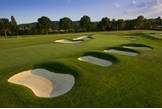Greens quicker than Augusta and 300-yard par-3s… welcome to the US Open at Oakmont
Published: Last updated:
It’s less than two months until the second major of the year, the US Open at Oakmont Country Club in Pennsylvania.
The US Open is a major that prides itself on providing a real test for the world’s best golfers. When Rory McIlroy had the temerity to blast his way to a record 16-under winning total in 2011, the USGA made sure the course the following year was more than ready to protect itself. Hugely dominant performances from McIlroy in 2011 and Kaymer in 2014 aside, any score under par will typically be good enough to get you in contention.
“The USGA wants the U.S. Open to be a tough, rigorous test,” says USGA Executive Director Mike Davis. “We want it to be the ultimate test in golf.”
Players can expect an extremely tough test this year. The last time the US Open was held at Oakmont was in 2007, when Angel Cabrera triumphed with a five-over par total.
Here are a few of the tricks Oakmont has up its sleeve…
Ridiculously quick greens
If you thought the greens at Augusta were quick, you ain’t seen nothing yet. Augusta’s greens tend to be about 12-12.5 on the Stimpmeter. At Oakmont, they’re between 12.5-13.5 – although some claim they can get as high as 17.
“If Oakmont has a signature, it has to be these lightning fast greens,” says Mike Davis. “And this isn’t a recent phenomenon. These greens have been like this really from day one. In fact if you go back to the 1935 US Open that was played here, the players were complaining incessantly about the greens being too fast. In fact some of them almost boycotted and didn’t want to play.”
Sam Parks Jr. won that year, with an 11-over par total. Unless the players can display immense touch with the flat stick, Oakmont might produce similar scoring this time round.
And insanely fast fairways
We could describe how hard and fast the fairways at Oakmont will be, but we’ll let you watch this video instead.
That was a putt from 118 yards.
You might be thinking that fast fairways are a good thing, helping drives roll out further. That may be the case, but it also makes it significantly more challenging to keep your ball on the short grass, particularly when there are undulations to take it sideways into one of the hundreds of fairway bunkers.

A 300-yard par-3
The USGA first introduced a par-3 over 300 yards during the 2007 US Open. In one round that year, the 8th tee was pushed back to make the hole 305 yards, leading Phil Mickelson to state it should have been a par 3.5 and Paul Goydos to joke that the USGA had done well to create a hole that could host a long drive and nearest to the pin contest at the same time. Jokes aside, only 26.7% of shots found the green that year.
“Before everybody thinks we have lost our marbles making a par-3 300 yards, when you go back and you read historically about what Fownes wanted, they designed that hole to be a driver, 3-wood hole,” says Davis. “The only way to get it to that way now days is to get something back there.”
Dry water hazards
Bad news: you’ve hit your ball into a water hazard.
Good news: there’s no water in any of them, so you can play it out.
Bad news: they’re filled with thick grass and weed, making playing it out really difficult.
Really bad news: you’re still in there three shots later, wishing you’d taken a drop.
“From a strategic standpoint it’s fascinating, because when a player gets his ball in, he’s going to have a chance to play out, but it’s not always a sure thing coming out,” says Davis.


